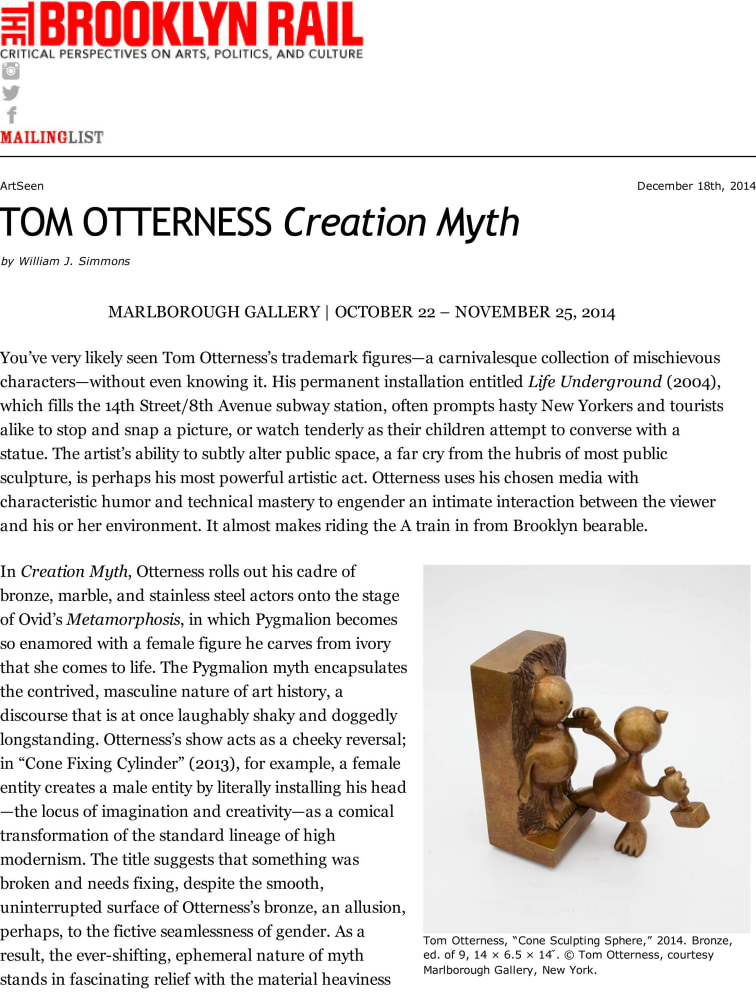
MARLBOROUGH GALLERY | OCTOBER 22 – NOVEMBER 25, 2014
You’ve very likely seen Tom Otterness’s trademark figures—a carnivalesque collection of mischievous characters—without even knowing it. His permanent installation entitled Life Underground (2004), which fills the 14th Street/8th Avenue subway station, often prompts hasty New Yorkers and tourists alike to stop and snap a picture, or watch tenderly as their children attempt to converse with a statue. The artist’s ability to subtly alter public space, a far cry from the hubris of most public sculpture, is perhaps his most powerful artistic act. Otterness uses his chosen media with characteristic humor and technical mastery to engender an intimate interaction between the viewer and his or her environment. It almost makes riding the A train in from Brooklyn bearable.
Similarly, “Cone Sculpting Sphere” (2014), gendered only by the associations we have with triangles and female restrooms, suggests a new Pygmalian story wherein it is the man who emerges from stone at the behest of a woman. The sculptor, who could tentatively be called “female,” has one foot in our world and the other in the space of creation. Woman, thereby, becomes the mediator of the creative process. The rigid yet formless realm of pure material from which the sculpted figure emerges complicates the uninterrupted exterior of the sculpture, reminding the viewer that sculpture, like identity politics, is the synthesis of physical and conceptual modes. Yet none of the sculptures’ titles indicate sex; rather, Otterness names them only by the shapes involved. Gendered associations with shapes are, like art, fabricated.In Creation Myth, Otterness rolls out his cadre of bronze, marble, and stainless steel actors onto the stage of Ovid’s Metamorphosis, in which Pygmalion becomes so enamored with a female figure he carves from ivory that she comes to life. The Pygmalion myth encapsulates the contrived, masculine nature of art history, a discourse that is at once laughably shaky and doggedly longstanding. Otterness’s show acts as a cheeky reversal; in “Cone Fixing Cylinder” (2013), for example, a female entity creates a male entity by literally installing his head—the locus of imagination and creativity—as a comical transformation of the standard lineage of high modernism. The title suggests that something was broken and needs fixing, despite the smooth, uninterrupted surface of Otterness’s bronze, an allusion, perhaps, to the fictive seamlessness of gender. As a result, the ever-shifting, ephemeral nature of myth stands in fascinating relief with the material heaviness of Otterness’s sculptures, opening both sculptural practice and gendered discourse to critique and reconfiguration.
Perhaps, then, Otterness is pointing to universal aesthetic forms, like Wassily Kandinsky’s Suprematist compositions or Donald Judd’s repetitions of shapes. However, as art historian Anna Chave famously argued, the Minimalist urge toward an apolitical form of expression through hefty materials—privileged exactly because of their masculine connotations of strength and permanence—was its own kind of sexism. But the constant, flamboyant transformation of shapes in Creation Myth manages to circumvent such chauvinism; despite their intensely physical and, at times, imposing presence, the sculptures also convey a lighthearted self-criticality. Universal forms such as those found in “Cone and Cube” (2014), do not represent an unchanging space separate from lived experience; Otterness’s forms are perpetually becoming, figures that come to life as they are removed from a mold like a newborn. His work is contingent, sincere, and unafraid to expose the mechanics of its making.
Like Lily van der Stokker’s unabashedly pink installations shown at Koenig and Clinton earlier this year, Otterness’s work refuses the vanity of the “art object” in order to affect a more powerful, nuanced, and accessible relationship between his sculptures and his viewers. Otterness creates forms that are at once purely formal and entirely embodied, a kind of social formalism. This revolutionary act gives rise to an ethos of understated subversion, a place where we can engage with the critical function of art without the stifling pretention of normative art historical narratives. Combining humble materials with enviable skill and conceptual astuteness, Creation Myth is an arena of experimental ideas, free for all to enjoy.